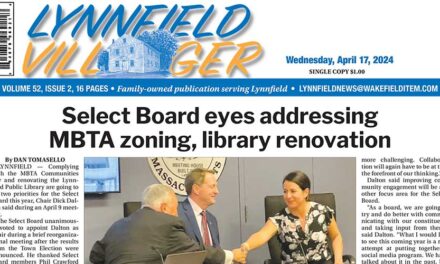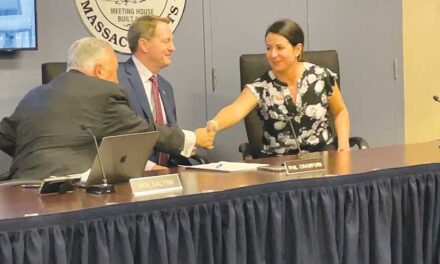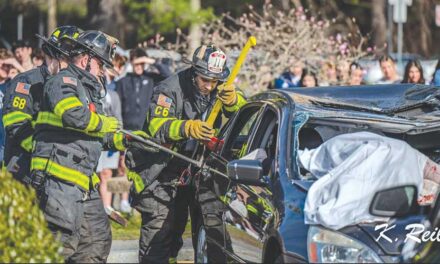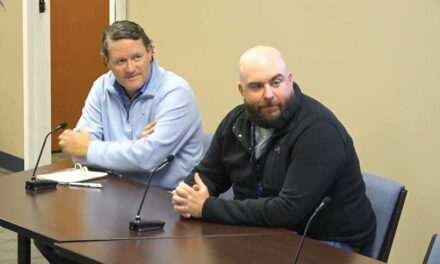Published in the January 20, 2016 edition
By MARK SARDELLA
WAKEFIELD — Dozens of Wakefield residents and some Lynnfield residents came out Jan. 13 to an informational meeting on the proposed Rail Trail that would run from the Junction area in Wakefield, through Lynnfield to the Peabody line.
The meeting, held at the Galvin Middle School, consisted of a presentation by the engineers working on the design of the project as well as some words from Wakefield town officials.
Wakefield Town Administrator Stephen P. Maio welcomed those in attendance before introducing Janet Long, chairman of the Lynnfield Recreational Path Committee. Long was filling in for Wakefield Rail Trail Committee Chairwoman Dot Halpin who was unable to attend the meeting. Long credited Halpin “for bringing things to this point.”
Long said there were over 70 similar trails in the state and presented the trail as a way for kids to transport themselves around the towns by bike and on foot in a safe way, in addition to its recreational benefits. She noted that it would pass close by several schools in both towns.
Long said that such trails are good for business and are recognized by federal and state agencies as valuable projects worthy of funding. She maintained that crime rates remain unchanged or are reduced by the presence of such recreational trails and that abutting property values tend to increase.
Richard Benevento, president of WorldTech Engineering described the scope of the proposed 4.4-mile Rail Trail, noting that it would extend from the Galvin Middle School along the abandoned Newburyport rail line through Lynnfield to Peabody. It would run for 1.82 miles in Wakefield and 2.53 miles in Lynnfield. About 0.6 miles of the Lynnfield portion would go through Reedy Meadow.
Benevento outlined the steps involved in bringing forward the proposed Wakefield-Lynnfield Rail Trail project. He said that the concept was submitted two years ago to the Massachusetts Department of Transportation (MassDOT), which determined that it was eligible for $7.6 million to fully fund the construction. It is on MassDOT’s list to be funded in FY 2018, but could be pushed back if the project is not ready, Benevento said.
He noted that the design team has completed the preliminary design and plans to submit the completed 25 percent design to MassDOT this summer. If it goes forward, the project will continue to come back to both Wakefield and Lynnfield for input and approval at every stage of the process.
“It’s a long process,” Benevento said. “It’s very detailed and it’s very comprehensive.” He said that it was the job of the design team to tailor the project to community needs.
Benevento introduced Bill Mertz, vice president and project manager at WorldTech, to discuss some of the engineering that has been done as well some of the design features of the proposed trail.
Mertz said that the trail would be 12 feet wide and paved, but could narrow to 10 feet in environmentally sensitive areas. He discussed some of the safety features that could be implemented to announce where the trail crosses roadways, including signs, flashing lights and landscaping options.
Mertz talked about the original idea of using a string of abandoned rail cars to cross the Reedy Meadow wetland but said that the plan was scrapped for logistical and cost reasons in favor of an elevated boardwalk structure.
Bill McGrath, an engineer with BETA Group, provided some detail on the proposed boardwalk that would be elevated a few feet above the tracks and would have 4-foot high railings. He said that “pull-off” areas would be included for wildlife viewing.
Ann Marton, president of LEC Environmental Consultants, said that the boardwalk would be designed in an environmentally sensitive way. She insisted that the boardwalk would have little or no long term impact on the environment and wildlife.
Randy Collins of BETA Group discussed the landscaping and other features along the rail trail. He talked about the trailhead design, including parking, bike racks, benches, trash containers, etc.
He listed screening alternatives for abutting private properties that could include fencing, arborvitaes, shrubbery and combinations of those. He also discussed amenities along the trail.
Collins also talked about some of the safety measures that could be used at intersections with roadways to alert both trail users and motorists to the crossing.
He noted that such trails tend to be low-cost to maintain as volunteers are generally eager to come forward and do routine cleanup and maintenance.
During a question and answer period, one Wakefield resident said that she had read in the Wakefield Daily Item that there was significant opposition to the rail trail among Lynnfield abutters. She wondered if one town’s opposition could derail the whole project.
Benevento stressed that each town has jurisdiction over its own portion of the trail. He said that opposition in Lynnfield would not derail the Wakefield section.
Daniel Tammaro of Lynnfield insisted that opposition to the rail trail in Lynnfield was not limited to abutters. He also said that he was affronted by Wakefield being the lead community for the project.
Benevento explained that the reason Wakefield is the lead agency is because MassDOT needed to enter into an agreement with one community to administer the project, and at the time Wakefield was further along in its preparation and agreed to be the lead community. He stressed that being the lead community does not mean that Wakefield gets to dictate what happens in Lynnfield. It simply means that Wakefield administers the finances with MassDOT.
Attendees broke off into smaller groups to sit with members of the design team and ask questions and provide feedback. Questions were raised regarding ways to prevent trail-users from parking on residential neighborhood streets.
Other questions discussed in the group sessions included screening and privacy for abutters and the potential for increased flooding due to trail construction.
When the general meeting reconvened, Wakefield DPW Director Richard Stinson said that safety tends to improve when trails are built, as undesirable elements tend to disappear when the trails become public spaces. He said that he and Wakefield Town Engineer Michael Collins would be happy to sit down with any residents to go over questions and concerns.
The design team was slated to make a similar presentation in Lynnfield on Jan. 12, but the meeting was canceled because it was not posted properly 48 hours in advance as required under the state’s Open Meeting Law. A new date will be announced when it is scheduled.




